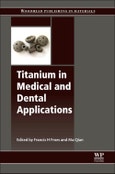Titanium in Medical and Dental Applications is an essential reference book for those involved in biomedical materials and advanced metals. Written by well-known experts in the field, it covers a broad array of titanium uses, including implants, instruments, devices, the manufacturing processes used to create them, their properties, corrosion resistance and various fabrication approaches. Biomedical titanium materials are a critically important part of biomaterials, especially in cases where non-metallic biomedical materials are not suited to applications, such as the case of load-bearing implants.
The book also covers the use of titanium for implants in the medical and dental fields and reviews the use of titanium for medical instruments and devices.
Please Note: This is an On Demand product, delivery may take up to 11 working days after payment has been received.
Table of Contents
Section 1: Summary of Titanium Alloy mechanical properties, corrosion resistance, fabrication approaches and Alloy Design for Biomedical Use 1.1: Titanium for Medical and Dental Applications, An Introduction 1.2: Advances in Titanium Metal Component Fabrication, An Overview 1.2 Design of Titanium Implants for Additive Manufacturing 1.3: The Molecular Orbital Approach and its Application to Biomedical Titanium Alloy Design 1.5 Additively Manufactured Ti-6Al-4V Lattice Structures for Medical Applications
Section 2: Titanium for Implants, Medical 2.1: Processing cannulated titanium bars for screws and nails in orthopedics: a proprietary approach 2.2: Transition of surface modification of titanium for medical and dental use 2.3: Modern methods of implant surface geometry modification of titanium and its alloys for enhanced biomedical characteristics 2.4: Surface Modifications and Cellular Responses of Biomedical Thin Films on Titanium Implants 2.5: The Effect of Nitinol on Medical Device Innovation 2.6: Additive Manufacturing of Ti alloys for Biomedical Applications 2.7: Titanium Spinal Fixation Devices 2.8: Biocompatible beta-Ti alloys with enhanced strength due to increased oxygen content 2.9: Nanostructured pure Ti for development of miniaturized biomedical implants 2.10: Mechanical performance and cell response of pure titanium with ultrafine grained structure produced by severe plastic deformation 2.11: 3-D Printed Ti-6Al-4V Implants 2.12: Microstructure and lattice defects in ultra-fine grained biomedical alpha + beta and metastable beta Ti alloys 2.13: Aluminum- and Vanadium-free Titanium Alloys for Application in Medical Engineering 2.14: Ti-Nb-Zr system and its surface biofunctionalization for biomedical applications
Section 3: Titanium for Implants, DentaL 3.1:Ti-6Al-4V orthopedic implants made by selective electron beam melting 3.2 3D Printed Titanium Alloys of Orthopedic Applications 3.3: 3D Printing of Low Modulus Titanium for Medical Applications
Section 4: Titanium Implants for Dental Applications 4.1: Why Titanium in Dental Applications 4.2: The role of Titanium Implants in Dentistry 4.3: Titanium MIM for manufacturing of medical implants and devices
Section 5: Nitinol Applications in Medical and Dental Applications 5.1: Nitinol and its Applications in Medical/Dental Device 5b 5.2: NiTi shape memory alloys for medical applications








